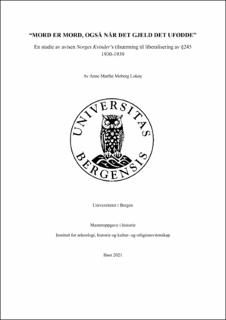“Mord er mord, også når det gjeld det ufødde" - en studie av avisen Norges Kvinder’s tilnærming til liberalisering av §245 1930-1939
Master thesis
Permanent lenke
https://hdl.handle.net/11250/2834967Utgivelsesdato
2021-11-23Metadata
Vis full innførselSamlinger
- Master theses [240]
Sammendrag
Denne avhandlingen tar sikte på å analysere hvordan avisen Norges Kvinder omtalte abort og §245 i straffeloven på 1930-tallet, og hvilke perspektiver og synspunkt den presenterer. For å besvare problemstillingen har det blitt undersøkt nærmere 300 aviser for å avgjøre hvordan avisen fremstilte saken, hvilke historiske hendelser den vektla, hvordan den argumenterte og hvilke aktører og organisasjoner som ble trukket frem. Hovedlinjen i analysen er kronologisk og kapitlene er dermed inndelt etter etter tidsperioder, hvor hvert kapittel tar for seg spesifikke år i debatten. Det første kapittelet tar for seg årene 1930-1933, og ser på hvordan debatten utfoldet seg i disse tidlige årene og hvordan avisen stilte seg til abortspørsmålet i tiden etter Kristen Andersen tok opp temaet i 1929. Det andre kapittelet undersøker perioden 1934-1935 og tar opp Straffelovskomiteens innstilling, den økte motstanden fra kristne organisasjoner og avisens kampanje for kirurgen Louise Isachsens restriktive lovforslag. Det siste analysekapittelet vil se på de resterende årene, 1936-1939. Abortdebatten i Norge var ikke lenger like aktiv i disse årene fordi regjeringen fremdeles ikke hadde fremmet en proposisjon, og avisen skrev derfor mye om abortdebattene fra andre europeiske land som Danmark, Sverige, Frankrike og Sovjetunionen. I tillegg publiserte overlege Harald Natvig et lovforslag som bygget videre på Isachsens forslag; et forslag som Norges Kvinder trykket mange artikler og omtaler om. Avhandlinger finner at Norges Kvinder tok klar avstand fra abort på sosial indikasjon gjennom hele den aktuelle tidsperioden. Avisen publiserte egne artikler for å advokere sitt syn, samtidig som de hentet inn artikler fra andre aviser og etterspurte uttalelser fra organisasjoner og aktører som de etter all sannsynlighet visste støttet deres perspektiv i saken. Abortdebatten ble fremstilt svært ensidig gjennom manglende representasjon fra abortforkjemperne i avisens fremstilling, og argumentasjonen bygget i stor grad på en kristen livsvurdering og synet på livet som hellig helt fra unnfangelse. Dette synet ble langt tydeligere fra midten av 1930-tallet, noe som førte til en sterkere religiøs argumentasjon og en krassere motstand mot en liberalisert abortlov. I tillegg viste analysen av kildematerialet hvordan den religiøse motstanden ønsket abort og sterilisering på eugenisk indikasjon, til tross for at det i teorien stred mot prinsippet om livets hellighet, som var et av hovedargumentene imot de sosiale indikasjonene. This thesis' main focus is to analyze how the newspaper Norges Kvinder discussed abortion and §245 in the criminal law during the 1930s, and what perspectives and views it presents. To answer the issue presented in this essay, close to 300 newspapers have been investigated in order to determine how the newspaper perceived the case, what historical events it focused on, how it argued and what actors and organizations were mostly focused on. The analysis follows a chronological order, making the chapters divided into different time periods, where each chapter discusses one period of time during the debate. The first chapter discusses the years 1930-1933 and looks into how the debate unfolded during these early years as well as looking at how the newspaper looked at the question about abortion after Kristen Andersen brought the subject up in 1929. The second chapter investigates the period 1934-1935 and brings up the recommendation of the criminal law committee, the increasing resistance from Christian organizations and the newspaper's campaign for the surgeon Louise Isachsen's restrictive bill. The final analysis chapter will investigate the remaining years, 1936-1939. During these years, the abortion debate was no longer as active due to the government still not having presented a proposition, and therefore the newspaper wrote about the abortion debate in other European countries such as Denmark, Sweden, France and the Soviet Union. In addition, chief surgeon Harald Natvig, published a bill building on Isachsen's suggestion; a suggestion Norges Kvinder wrote a lot about. The thesis finds that Norges Kvinder were against abortion on social indication throughout the entire period in question. The newspaper published articles to advocate their view, as well as using articles from other newspapers and request statements from organizations and actors; whom they likely knew supported their view on the case. The abortion debate was presented very one-sided through missing representation from abortion advocates, as well as the arguments largely building on a Christian life assessment and the view of life as holy from the moment of conception. This view was far more prominent from the middle of the 1930s, which led to stronger religious argument and a stronger resistance towards a liberalized abortion law. In addition, the analysis of the sources showed how the religious resistance wanted abortion and sterilization on eugenic indication, despite that it in theory was contrary to the principle of life's inviolability, which was one of the main arguments against the social indications.
